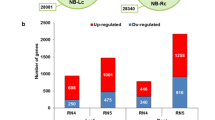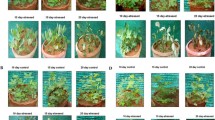Abstract
A 104 kDa protein (SAP 104) accumulates in rice seedlings in response to several abiotic stress conditions and immunological homologues of rice SAP 104 have been detected in several monocot and dicot species, as also Neurospora crassa, a fungus. In this report, we show that the amino acid sequence of a tryptic peptide generated from purified SAP 104 bears significant homology with an ATP-binding domain of the HSP 100 family proteins of Arabidopsis thaliana and Glycine max. It is further shown that differential uninduced and induced (by high-temperature stress) levels of this protein are accumulated in various organs of the mature rice plant grown under field conditions. Significant uninduced levels of this protein were in particular found in developing and mature rice grains. Seeds/grains of several other plant genera (i.e. Triticum aestivum, Zea mays, Brassica juncea) were also found to contain high uninduced levels of SAP 104. Importantly, the levels of uninduced SAP 104 in rice grains were found to decline during the seed germination phase: after two days of germination, this protein was undetectable in tissues representing pooled sample of seeds and just-emerged seedlings. Tissue print-immunoblotting analysis has indicated that in seeds high levels of this protein are specifically present in the embryo portion.
Similar content being viewed by others
References
Abernathy R, Thiel DS, Petersen NS, Helm K: Thermotolerance is developmentally dependent in germinating wheat seeds. Plant Physiol 89: 569–579 (1989).
Almoguera C, Jordano J: Development and environmental concurrent expression of sunflower dry-seed-stored lowmolecular weight heat shock protein and Lea mRNAs. Plant Mol Biol 19: 781–792 (1992)
Altschul SF, Gish W, Miller W, Myers EW, Lipman DJ: Basic local alignment search tool. J Mol Biol 215: 403–410 (1990).
Boston RS, Viitanen PV, Vierling E: Molecular chaperones and protein folding in plants. Plant Mol Biol 32: 191–222 (1996).
Carper SW, Duffy JJ, Gerner EW: Heat shock proteins in thermotolerance and other cellular processes. Cancer Res 47: 5249–5255 (1987).
Coca MA, Almoguera C, Jordano J: Expression of sunflower low molecular-weight heat-shock proteins during embryogenesis and persistence after germination: localization and possible functional implications. Plant Mol Biol 25: 479–492 (1994).
DeRocher AE, Vierling E: Developmental control of small heat shock protein expression during pea seed maturation. Plant J 5: 93–102 (1994)
DeRocher A, Vierling E: Cytoplasmic HSP70 homologues of pea: differential expression in vegetative and embryonic organs. Plant Mol Biol 27: 441–456 (1995).
Gish W, States DJ: Identification of protein coding regions by database similarity search. Nature Genet 3: 266–272 (1993).
Gottesman S, Squires C, Pichersky E, Carrington M, Hobbs M, Mattick JS, Dalrymple B, Kuramitsu H, Shizoza T, Foster T, Clark WP, Ross B, Squires C, Maurizi R: Conservation of the regulatory subunit for the Clp ATP-dependent protease in prokaryotes and eukaryotes. Proc Natl Acad Sci USA 87: 3513–3517 (1990).
Heikkila JJ: Heat shock gene expression and development. I. An overview of fungal, plant and poikilothermic animal developmental systems. Devel Genet 14: 1–5 (1993).
Heikkila JJ: Heat shock gene expression and development. II. An overview of mammalian and avian developmental systems. Devel Genet 14: 87–91 (1993).
Hernandez LD, Vierling E: Expression of low molecular weight heat-shock proteins under field conditions. Plant Physiol 101: 1209–1216 (1993).
Howarth CJ, Ougham HJ: Gene expression under temperature stress. New Phytol 125: 1–26 (1993).
Kawai M, Uchimiya H: Tissue specific localization of adenylate kinase in rice (Oryza sativa L.) plants. J Plant Physiol 146: 239–242 (1995).
Laemmli UK: Cleavage of structural proteins during the assembly of the head of bacteriophage T4. Nature 227: 680–685 (1970).
Lee YRJ, Nagao RT, Key JL: A soybean 101-kD heat shock protein complement a yeast HSP 104 deletion mutant in acquiring thermotolerance. Plant Cell 6: 1889–1897 (1994).
Nagao RT, Kimpel JA, Key JL:Molecular and cellular biology of the heat-shock response. In: JG Scandalios (ed) Advances in Genetics, vol 28, pp. 235–274. Academic Press, New York (1990).
Neumann D, Nover L, Parthier B, Rieger R, Scharf KD, Wollgiehn R, Nieden VZ: Heat shock and other stress response systems of plants. Biol Zentralbl 108: 1–156 (1989).
Parsell DA, Kowal AS, Singer MA, Lindquist S: Protein disaggregation mediated by heat shock protein HSP 104. Nature 372: 475–478 (1994).
Parsell DA, Sanchez Y, Stitzel JD, Lindquist S: Hsp 104 is a highly conserved protein with two essential nucleotide binding sites. Nature 353: 270–273 (1991).
Pareek A, Singla SL, Grover A: Immunological evidence for accumulation of two high-molecular-weight (104 and 90 kDa) HSPs in response to different stresses in rice and in response to high temperature stress in diverse plant genera. Plant Mol Biol 29: 293–301 (1995).
Pareek A, Singla SL, Grover A: Salt responsive proteins/genes in crop plants. In: Jaiwal PK, Singh RB, Gulati A (eds) Strategies for Improving Stress Tolerance in Higher Plants, Oxford and IBH, New Delhi (1997).
Pareek A, Singla SL, Kush AK, Grover A: Distribution patterns of HSP 90 protein in rice. Plant Sci 125: 221–230 (1997).
Petersen NS: Effects of heat and chemical stress on development In: Scandalios JG (ed) Advances in Genetics, vol. 28, pp. 275–296. Academic Press, New York, (1990).
Prasad TK, Stewart CR: cDNA clones encoding Arabidopsis thaliana and Zea mays mitochondrial chaperonin HSP 60 and gene expression during seed germination and heat shock. Plant Mol Biol 18: 873–885 (1992).
Rosenfeld J, Capedeville J, Guillemot JC, Ferrara P: In-gel digestion of proteins for internal sequence analysis after one or two dimensional gel electrophoresis. Anal Biochem 203: 173–179 (1992).
Sanchez Y, Lindquist SL: Hsp 104 is required for induced thermotolerance. Science 248: 1112–1115 (1990).
Schirmer EC, Lindquist S, and Vierling E: An Arabidopsis heat shock protein complements a thermotolerance defect in yeast. Plant Cell 6: 1899–1909 (1994).
Singla SL, Grover A: Detection and quantitation of a rapidly accumulating and predominant 104 kDa heat shock polypeptide in rice. Plant Sci 97: 23–30 (1994).
Singla SL, Grover A: Antibodies raised against yeast HSP 104 cross-react with a heat-and abscisic acid-regulated polypeptide in rice. Plant Mol Biol 22: 1177–1180 (1993).
Singla SL, Pareek A, Grover A: High temperature. In: Prasad MNV (ed) Plant Ecophysiology pp. 101–127. John Wiley, Sons, New York (1997).
Singla SL, Pareek A, Grover A: Yeast HSP 104 homologue rice HSP 110 is developmentally-and stress-regulated. Plant Sci 125: 211–219 (1997).
Vierling E: The roles of heat shock proteins in plants. Annu Rev Plant Physiol Plant Mol Biol 42: 579–620 (1991).
Author information
Authors and Affiliations
Rights and permissions
About this article
Cite this article
Lata Singla, S., Pareek, A., Kumar Kush, A. et al. Distribution patterns of 104 kDa stress-associated protein in rice. Plant Mol Biol 37, 911–919 (1998). https://doi.org/10.1023/A:1006099715375
Issue Date:
DOI: https://doi.org/10.1023/A:1006099715375




